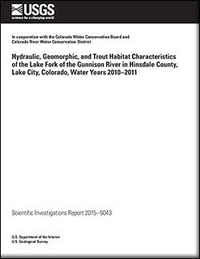Hydraulic, geomorphic, and trout habitat conditions of the Lake Fork of the Gunnison River in Hinsdale County, Lake City, Colorado, Water Years 2010-2011
Links
- More information: USGS Index Page
- Document: Report (28.4 MB pdf)
- Download citation as: RIS | Dublin Core
Abstract
Channel rehabilitation, or reconfiguration, to mitigate a variety of riverine problems has become a common practice in the western United States. However, additional work to monitor and assess the channel response to, and the effectiveness of, these modifications over longer periods of time (decadal or longer) is still needed. The Lake Fork of the Gunnison River has been an area of active channel modification to accommodate the needs of the Lake City community since the 1950s. The Lake Fork Valley Conservancy District began a planning process to assess restoration options for a reach of the Lake Fork in Lake City to enhance hydraulic and ecologic characteristics of the reach. Geomorphic channel form is affected by land-use changes within the basin and geologic controls within the reach. The historic channel was defined as a dynamic, braided channel with an active flood plain. This can result in a natural tendency for the channel to braid. A braided channel can affect channel stability of reconfigured reaches when a single-thread meandering channel is imposed on the stream. The U.S. Geological Survey, in cooperation with the Colorado Water Conservation Board and Colorado River Water Conservation District, began a study in 2010 to quantify existing hydraulic and habitat conditions for a reach of the Lake Fork of the Gunnison River in Lake City, Colorado. The purpose of this report is to quantify existing Lake Fork hydraulic and habitat conditions and establish a baseline against which post-reconfiguration conditions can be compared. This report (1) quantifies the existing hydraulic and geomorphic conditions in a 1.1-kilometer section of the Lake Fork at Lake City that has been proposed as a location for future channel-rehabilitation efforts, (2) characterizes the habitat suitability of the reach for two trout species based on physical conditions within the stream, and (3) characterizes the current riparian canopy density.
The FaSTMECH computational flow-model within MD_SWMS was selected to characterize the effects of streamflow on hydraulic and habitat-suitability conditions for a study reach of the Lake Fork. Habitat suitability was evaluated for cutthroat (Oncorhynchus clarkii) and brown trout (Salmo trutta morpha fario) fry, juveniles, and adults. Microscale (point locations) and mesoscale (reach features) habitats were assessed using the combination of field observations, measurements, and hydraulic simulations within the study reach of the Lake Fork. Microscale trout habitat, presented as weighted usable area, generally increased as streamflow increased for both trout species and all life stages. Areas of suitable microscale habitat occur along the banks for flows of 900 cubic feet per second (ft3/s) and less. Out-of-bank areas became more substantial contributors to overall habitat availability for flows of 1,300 ft3/s or more when compared to other features. Adult habitat, for both trout species, was the most abundant habitat type for nearly all streamflows. In general, the upper reach provided 2–3 times more available habitat than the lower reach for both trout species.
Mesoscale trout habitat of the Lake Fork was assessed based on the conditions present in the 150 ft3/s flow simulation as well as field observation. Both the upper and lower reach is primarily characterized as riffle/run habitat. The presence of pool habitat was limited throughout both reaches and occurred along the channel margins. For both reaches, the pool habitat was less than 5 percent of the total wetted area, a percentage that is substantially lower than the recommendations for sustainable populations of 40–70 percent. Areas of cover were adjacent to potential drift feeding areas in the lower reach, and often occurred within the same pool habitat. This may favor energy expenditure ratios of both fish species, wherein little energy is needed to acquire adequate food sources.
Sediment mobility is an important process for flushing fine sediments from within the gravel frameworks. Evaluations of channel and flow characteristics at cross-section locations 2–8 show a range of streambed mobility. In general, boundary shear stress and streambed mobility increase with increases in streamflow. Within the cross sections, the greatest boundary shear stress occurs towards the center of the channel. Reach-scale assessment of sediment mobility in the lower reach shows increased streambed mobility. This is due in part to smaller grain sizes in the lower reach, but may also reflect the greater extent of channel alterations, specifically the temporary berms constructed by CDOT in the late 1980s and 1990s, present in this reach.
Study Area
| Publication type | Report |
|---|---|
| Publication Subtype | USGS Numbered Series |
| Title | Hydraulic, geomorphic, and trout habitat conditions of the Lake Fork of the Gunnison River in Hinsdale County, Lake City, Colorado, Water Years 2010-2011 |
| Series title | Scientific Investigations Report |
| Series number | 2015-5043 |
| DOI | 10.3133/sir20155043 |
| Year Published | 2015 |
| Language | English |
| Publisher | U.S. Geological Survey |
| Publisher location | Reston, VA |
| Contributing office(s) | Colorado Water Science Center |
| Description | vi, 28 p. |
| Time Range Start | 2010-01-01 |
| Time Range End | 2011-12-31 |
| Country | United States |
| State | Colorado |
| County | Hinsdale County |
| City | Lake City |
| Online Only (Y/N) | Y |
| Additional Online Files (Y/N) | N |


